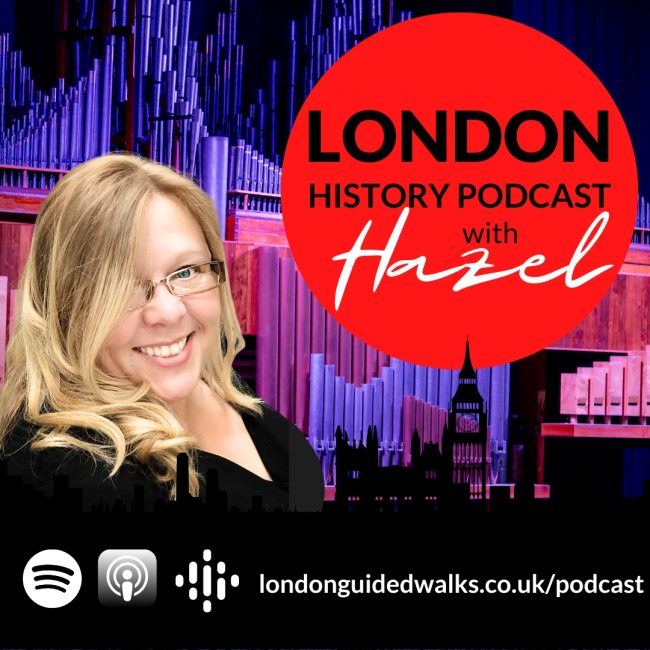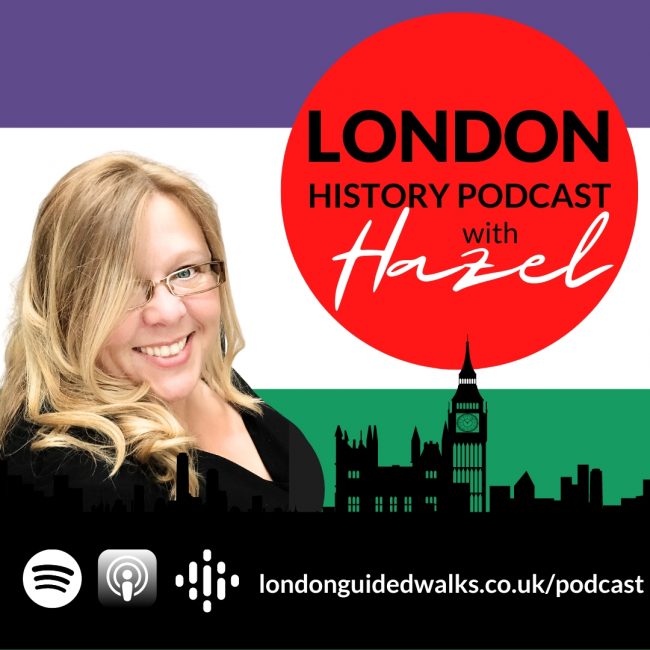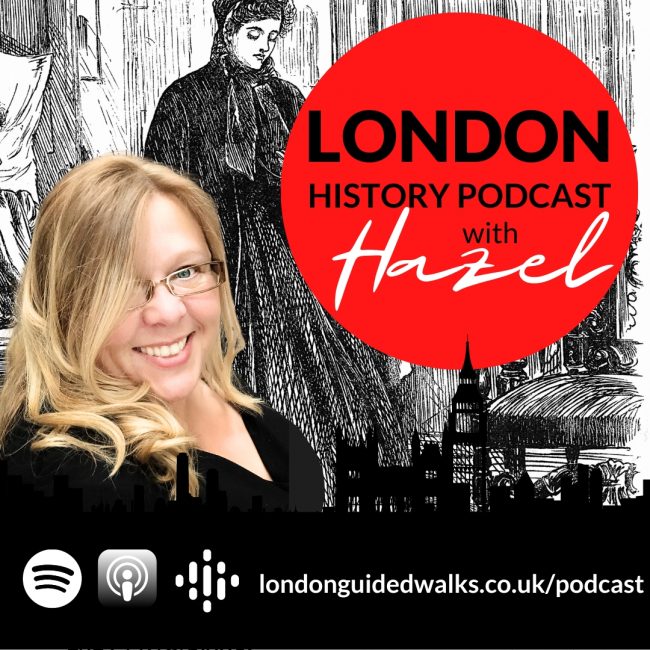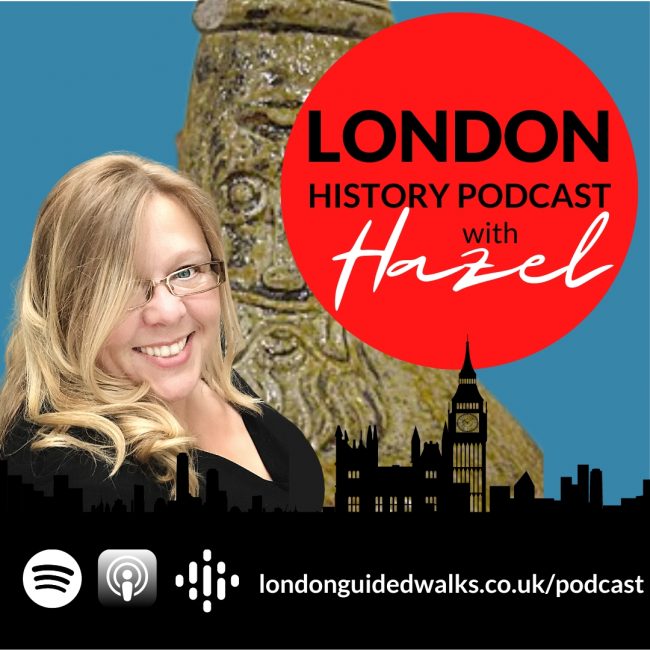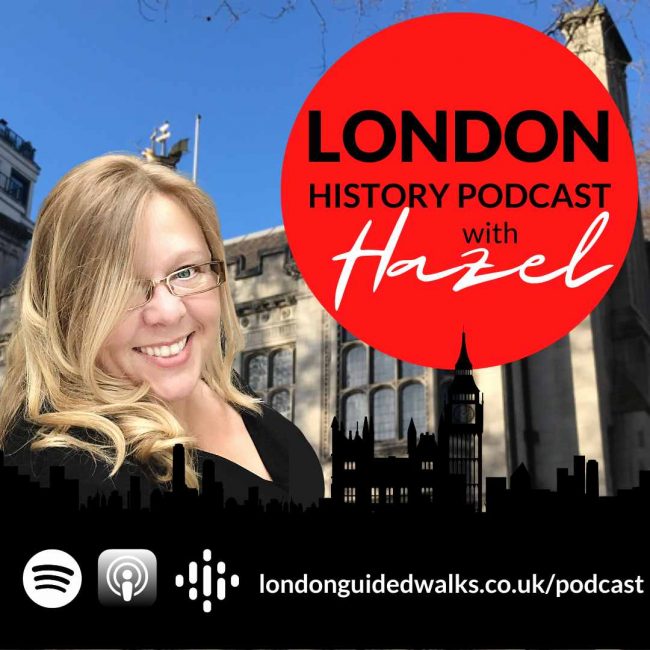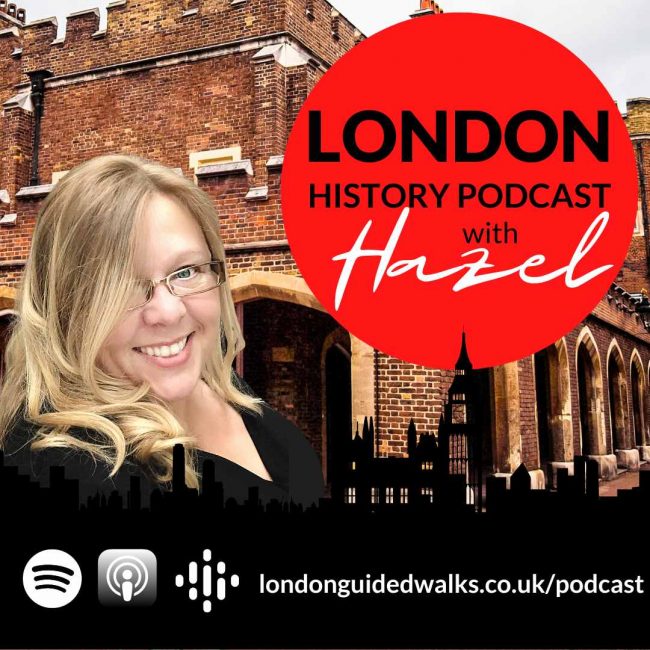Recommended Reading:
Show Notes:
 Hazel Baker: Hello and welcome to London Guided Walks London History podcast. In the coming episodes, we will be sharing our love and passion for London, its people, places and history in an espresso shot with a splash of personality. For those of you who don’t know me, I am Hazel Baker, founder of London Guided Walks, providing guided walks and private tours to Londoners and visitors alike.
Hazel Baker: Hello and welcome to London Guided Walks London History podcast. In the coming episodes, we will be sharing our love and passion for London, its people, places and history in an espresso shot with a splash of personality. For those of you who don’t know me, I am Hazel Baker, founder of London Guided Walks, providing guided walks and private tours to Londoners and visitors alike.
Don’t forget, our blog is regularly updated with posts written by our passionate team of quantified London tour guides. There are literally hundreds to choose from all absolutely free.
Thank you to everybody for supporting the podcast and listening to it. We’ve had over 22,000 downloads already. It’s really quite amazing. If you enjoy the podcast and please do a write a review, or least click those five stars. I read everybody’s comments and reviews and really do appreciate the time that it takes.
If you like Charles Dickens, then you will enjoy our Charles Dickens virtual tour. This is a recording of a live virtual tour I did for the paying public and you’re able to pay and play and watch it in your own time. And it looks at Charles Dickens and his works and his 48 year old relationship with London.
So let’s get on with today’s theme, which is Charles Dickens in Greenwich. I’ve tried to include as many quotes from Charles Dickens as possible and to help with the flow of it all I have been assisted by London tour guide Ian McDiarmid who will be the voice of Charles Dickens.
The Victorian author Charles Dickens writes about Greenwich in a number of places, including magazines, such as The Uncommercial Traveller and Household Words and then also in some of his novels such as Bleak House and Our Mutual friend. Sometimes it’s a small mention, the smallest of small such as in David Copperfield, where our hero “gave up the pursuit of the young man with the donkey-cart and started for Greenwich; from full-scape description of the fun of Greenwich Fair in Sketches by Boz and the goings on in our mutual friend.
Greenwich and Greenwich Park became one of London’s popular areas for leisure in the early 19th century. As the century progressed, Greenwich park increased in popularity. This was in part due to the improved transport links; the new Greenwich Pier was built in 1836 and it welcomed day-trippers coming via the Thames.
The London and Greenwich Railway (L&GR) was opened in 1838, enabling people to venture from London Bridge along the four mile viaduct to Greenwich, London’s first railway today. Listen to our episode about London’s First Railway.
Greenwich has many attractions for the day-tripper and that could have been said in the 19th century, even though the attractions have changed somewhat, the Greenwich fair was the big draw back then.
And even though it existed in one form or another, since the early 18th century, it was at its height in the late 1830s and forties, and a fleet of 50 steam boats would with excited crowds from London, unloaded as many as 150,000 people a day. And don’t forget, the passengers are filled the first, second and third class drink averages two.
There were two Greenwich Fairs; one at Easter and another at Whitsun. Dickens writes at length on the Greenwich Fair in Sketches by Boz which was an initiative of everyday life and everyday people Britain in 1836 and 1837. He mentioned a wide variety of food available at the stores, including pickled salmon with fennel,..
Charles Dickens: …oysters with shells, as large as cheese plates and diverse specimens of snail… floating in a somewhat bilious-looking green, liquid.
Hazel Baker: Lovely.
Instead of the rides we would expect it a fair nowadays. Greenwich Fair was unique and it featured Greenwich Hill. It was also known as the giant steps and it is on top of this, that people would launch themselves. The more reckless individuals chose the steeper hill under the terrace of the Royal Observatory.
And Dickins captured this runs it free for all known as tumbling.
Charles Dickens: Well, young men would drag young ladies up the steep hill, which leads to the observatory and then drag them down again at the very top of their speed, greatly to the derangement of their curls and bonnet cups and much to the edification of the lookers on below.
Hazel Baker: Greenwich fair does sound like it was a lot of fun.
Charles Dickens: Love-sick Swains under the influence of gin and water, and the tender passion become violently affectionate.
Hazel Baker: And we know that Dickens went to Greenwich several times when he was young, because he tells us…
Charles Dickens: in our earlier days, we were a constant frequenter of Greenwich fair for years
Hazel Baker: …and writes about its frivolity with fondness,
Charles Dickens: The gentlemen dominating the gay and festive scene with the more expensive ornaments of false noses and low crowned tinderbox looking hats, playing children’s drums and accompanied by ladies on the penny trumpet
Hazel Baker: In Dickens’ short story, Greenwich Fair. He shares a scene with us.
Charles Dickens: If the parks be the lungs of London, we wonder what Greenwich fare is a periodical breaking out. We suppose a sort of spring rash.
Hazel Baker: In 1835, a 13 year old boy was caught stealing a handkerchief from the pocket of a respectable gentleman in the crowd. Does that sound like maybe a character that, you know, in Oliver twist, which was written only two years later.
In 1960 and 61 Dickens writes The Uncommercial Traveller, which is a collection of literary sketches and he wanders the streets of London. And you also reminisces of his past, the Greenwich Pensioners were naval equivalents to the Chelsea Pensioner and they clearly left an impression on the young Dickens, as he describes the pensioner as having had a…
Charles Dickens: chequered career of blue water, black gunpowder, and red blood shed for England home and beauty.
Hazel Baker: The pensioners were rather interesting individuals and many clearly had a soft spot and also a reputation for the ladies. And they had a visible effect on the ladies too. Whenever a lady blushed, it was obvious.
Charles Dickens: Without looking round. There’s a Greenwich pensioner has gone past.
Hazel Baker: Greenwich Pensioners between 1705 and 1869. had lived in the Royal hospital for seamen now called The Old Royal Naval college. They were pensioners, they wore uniform of blue coats and tricorn hats. They lived with militarized rules and regulations, and any pensioner who was caught breaking those rules would have to wear a yellow coat and do menial tasks. And they were known as a Canary, the townspeople of Greenwich nicknames, the pensioners, the Greenwich geese. I can only imagine how they got that name.
Dickens also mentioned St. Alfege Church in Greenwich in Our Mutual Friend, where he describes a wedding officiated by the mockingly titled ‘Archbishop of Greenwich’
Charles Dickens: to see this salt old gruff and glum waving his shovel hat at Bella.
Hazel Baker: Old gruff and glum was the nickname for a charming gold pensioner who had the
Charles Dickens: gallantry over man of wards man and heart of oak.
Hazel Baker: Dickens’s portrayal of the Greenwich pensioners seems to be a respectful and positive one. Even in Bleak House, the Greenwich pensioners get a mention…
Charles Dickens: Fog in the eyes and throats of ancient Greenwich pensioners wheezing by the far sides of their wards, fog in the stem and bowl of the afternoon pipe at the rough for skipper down in his closed cabin, fog, cruelly, pinching the toes and fingers of his shivering little P ‘pentice boy on deck.
Hazel Baker: Fog is used by Dickens on a number of occasions, sometimes symbolises death and disease. Facing the river Thames where the tea clipper the Cutty Sark now stands was a Tavern called The Ship, aptly named given the nautical connections of Greenwich. It was here where the happy couple who had just wed at St. Alfege’s church had their wedding breakfast.
And Dickens himself was known to have dined here with friends such as artists, J. M. W Turner When Dickens was writing about the impoverished street children and society’s solution in dealing with the poor, Turner was painting The Fighting Temeraire voted England’s favourite painting in 2004 by BBC radios 4’s Today.
You might recognize it as being in the National Gallery, when James Bond, (Daniel Craig) meets the new Q (Ben Winshaw) voiceover Paddington bear.
The ship had undergone four incarnations since the 16th century, it was famous for its ministerial whitebait dinners which marked the end of a parliament session.
The Ship was an impressive Victorian Tavern by the time that Dickens and Turner of eating there with dining rooms named after heroes such as Nelson and Wellington. It had a ballroom lit by gas chandeliers designed for the great exhibition of 1851, seven private rooms and the all important Billiard Room.
The landlady was a successful business woman who knew how to make the most of an opportunity. And the popular whitebait dinners were that. They cost two shillings and 6 pence and she would serve a total of 40 orders in a day netting a gross take of £5 (pardon the pun) The total cost of fish that she spent? Well, that was three shillings and six pence. So, not a bad profit after all. And of course, even after her overheads, I think even Starbucks would appreciate her 2000% profits (and I bet she paid taxes!)
Another lost Greenwich location mentioned by Dickens is the Dreadnought hospital. The Siemens hospital society was founded in 1821 to provide medical care to merchant seaman and their dependence instead of a Victorian hospital, as we would imagine it with Stonewall’s tall ceilings, long lines and rows of hospital beds.
Well, this was something a little bit different. First off the hospital was in a 50 gun demasted, former Naval ship HMS Grampus, which was moored at Deptford. Within 10 years, the accommodation was inadequate. And so in 1831, the patients were moved to a three decked 104-gun ship called HMS Dreadnought.
And this was more just off Greenwich hospital. And we know Dickens visited the Dreadnought hospital when he was a reporter in his early career. 26 years later, they moved to an even bigger ship. This time, 120 gun HMS Caledonia, which was renamed HMS Dreadnought. Patients were finally moved to shore to the infirmary block of the Greenwich hospital.
When the block had become vacant in 1869, and it had 250 patients in 64 4-bedded wards with the own fireplaces. The hospital was renamed the Dreadnought Seamen’s hospital, but the Dreadnought herself remained in use as an isolation unit up until 1872. And after that, she was broken up.
In Dickens’s novel Dombey and Son, which follows the fortunes of a shipping firm owner, Dickens describes Captain Bunsby as having
Charles Dickens: had more accidents happen to his own self than the Seamen’s hospital to all hands.
Hazel Baker: Dickens also mentions the Dreadnought in his weekly magazine, which were basically a miscellaneous of fiction poetry and essays on varying subjects. It’s called Household Words. And also, that was the predecessor of all the year round. And he reports how clean and orderly everything was. And he seems somewhat bemused at the idea of a warship being used to heal sailors.
Charles Dickens: These within the bowl, walks originally built the purpose of smashing kind at large. They get tenderly, doctored and nursed.
Hazel Baker: I hope you’ve enjoyed this week’s episode and got to know Charles Dickens, his works in Greenwich a little bit more. We also do a Greenwich walk, both a public tour when COVID is a far distant memory and also a private tour, which you can book us.
That’s all for now. I’ll see you next week.

 Hazel Baker:
Hazel Baker: 